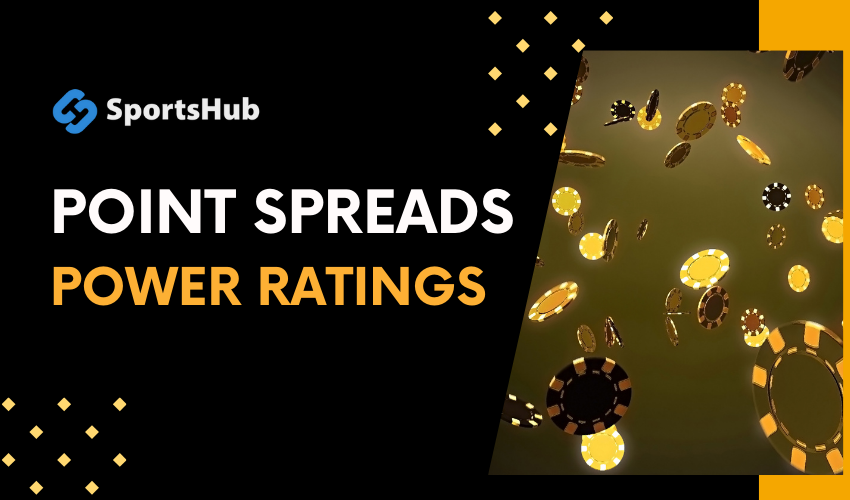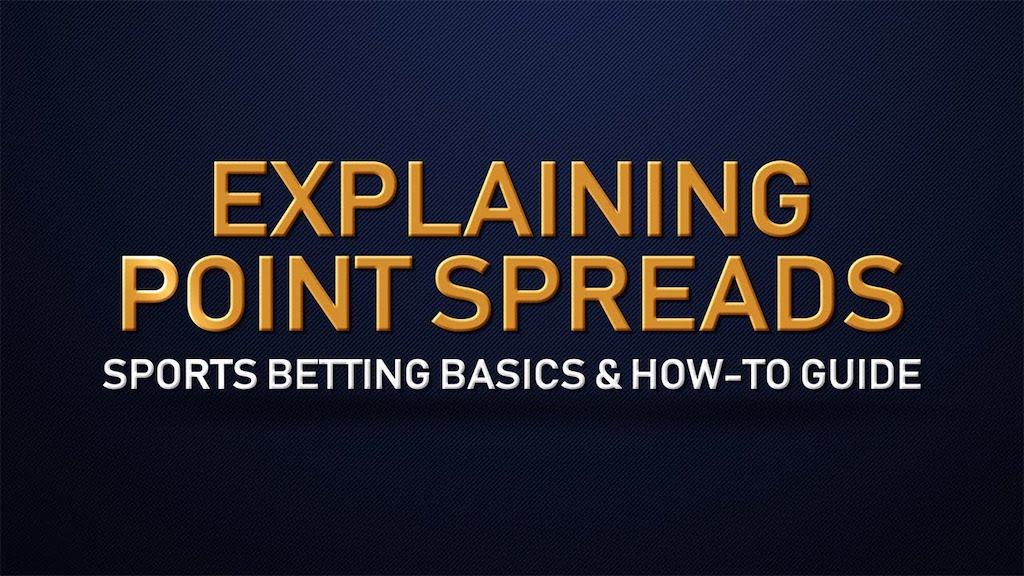Table of Contents
How to Bet the Point Spread
The most common type of sports bet in the US is a point spread bet. The main goal of point spread betting is to offer the chance to place bets on teams or athletes in a specific game by evaluating their relative strengths against one another.
In order to level the playing field between the two teams for potential bettors, the point spread uses the scoring units used in each sport (such as points, goals, runs, etc.) and projects the winning margin.
For example, in the majority of college football seasons, the Oklahoma Sooners will thrash the Kansas Jayhawks in a Big 12 matchup. Bettors can estimate the margin by which Oklahoma will beat them by using the point spread.
Say Oklahoma is a -34.5-point favorite. In order to win a bet on the Sooners, Oklahoma will have to win by five touchdowns (35 points). If Kansas somehow pulls the upset or loses by 34 points or less, a bet on the Jayhawks is a winner. That’s the power of point spread betting.
The Origins of the Point Spread
The introduction of the point spread utterly altered American sports betting. Football betting in particular received little attention for the majority of the 20th century. Many of the games were mismatches in which the outcome was obvious.
Since bettors didn’t want to back the underdog no matter how much money they were getting back, these games had little to no betting interest. Because of this, horse racing attracted significantly more betting interest than football at the time.
There is some controversy over where the point spread came from, but it most likely first appeared in use in the United States in Minneapolis during the 1930s. Several different bookmakers—among them Carl Ersine and Darby Hicks—claimed to be the creator of the point spread. The “Minneapolis Line” rose to prominence for many years and was broadcast all over the nation.
Despite some evidence that suggests point spreads were being used in the 1930s, Connecticut math teacher Charles K. McNeil is frequently cited as the creator of the point spread. He made the decision to change careers in the 1940s and started working as a bookmaker in Chicago. Working out of his office at the Chicago Gym Club, McNeil achieved success on both sides of the counter.
McNeil is one of the most significant bookmakers in U.S. history thanks to the point spread. Many of his colleagues believed he was better at betting and held his handicapping skills in high regard.
Point Spread Becomes Mainstream
McNeil is still often credited as the point spread founder. However, the point spread’s profile and its widespread usage is likely attributable to Jimmy “the Greek” Snyder. He was a former bookmaker in Las Vegas who became well-known as one of the members of the “NFL Today” show on CBS in the 1970s and 1980s.
Snyder actually had a huge following before he ever appeared on CBS. He was the go-to source for all things gambling related and was the manager of the downtown Las Vegas Sports and Turf Club. He earned the title “America’s Bookmaker” and earned his spot at CBS as a result. His notoriety led to more people becoming aware of the point spread. He also helped make the NFL the most popular betting sport in the U.S.
How Point Spread Betting Works

We should know by now that a point spread bet is a wager on the margin of victory in a sporting event. It is the most common kind of wager in both basketball and football.
To win your bet, the team that is thought to be superior, i.e. the favorite, must win by a predetermined number of runs, points, or goals. The inferior team, or the underdog, can either win the game outright or suffer a loss by fewer than that predetermined number of runs, points, or goals.
Let’s use an NFL game as an example. The Baltimore Ravens are a seven-point favorite against the New York Jets. The bet might look like this at your sportsbook.
- Baltimore Ravens -7 (-110)
- New York Jets +7 (-110)
If Baltimore wins by eight or more points, the cover the point spread. Those who bet on the Ravens are winners. The odds of -110 in parentheses indicate that a bettor must wager $110 to win $100 or $1.10 to win $1.00.
If the Ravens win by a margin of one through six points, the Jets cover the spread. If the Jets win, they also cover the spread. The odds are the same for a bet on New York. A $110 bet wins $100 if the Jets cover.
If the final score ends up 24-17 in favor of Baltimore, the result is called a “push.” There are no winners and all bets are refunded. A push occurs when the final result lands exactly on the point spread.
There are three possible results when betting on the point spread. Bettors can win because their team covered the spread. Bettors lose because their team did not cover the spread or the result is a push and their bets are refunded.
Difference Between Moneyline and Point Spread
The difference between a point spread bet and a moneyline bet is that a spread bet’s result does not always correspond to the outcome of the sporting event. The losing team in a point spread bet may still result in a win for bettors.
When placing a moneyline bet, bettors are selecting one team to win outright. When available, they can also select a draw as a potential outcome.
Go back to our initial example with Oklahoma and Kansas. If the Sooners beat Kansas 51-21, it’s a huge win for Oklahoma and for anyone that might have bet the Sooners on the moneyline. It’s a win for Kansas and anyone that bet on the Jayhawks to cover the spread. Despite losing by 30 points, the Jayhawks still covered since they lost by fewer than 34.5 points.
Point spreads are used in bets other than on final scores too. There are point spread bets on things like the number of corner kicks in a soccer match and on the total touchdowns in an NFL game.
Point Spread Odds – How to Bet the Point Spread
In the Ravens-Jets example above, we mentioned the odds on that bet. Typically, point spreads come with odds that are set by oddsmakers. The standard odds, or juice as it is known, is -110.
To understand why, consider the following. You have two friends and they bet $20 on the Super Bowl. You agree to hold the cash. You have $40. When the game ends, you hand the winner his initial stake of $20 plus the $20 from the loser. You end up with nothing.
In the example, you represent the sportsbook and if you don’t make any money you won’t be in business long. That’s why sportsbooks charge a small fee – juice or vig – on every bet. On point spread bets, that fee is usually 10 percent. That is why you will see (-110) attached to most point spread bets.
Those odds can change. You might see a -3 favorite given odds of -105. Keep in mind the goal of the sportsbook. The bookie wants to bring in an equal amount of action on both sides of the bet. When it’s all said and done, the bookie pays out the winnings and keeps the juice.
Setting the Point Spread: How to Bet Effectively

The spread is determined by sportsbooks or oddsmakers. Establishing a point spread is a process. There could be volumes written on how sportsbooks set point spreads, but to put it simply there are typically three steps.
Before a particular season begins, oddsmakers create mathematically based ratings for each team. They continue to adjust these ratings as the season progresses.
They calculate a point spread ahead of a game using those ratings as well as information on home-field advantage, rest, and injuries.
The point spread is then influenced by bets and moves to the most accurate number as a result of betting action.
Today, most sportsbooks simply copy the movement they see at the biggest books in the industry and do not develop their own lines.
Professional gamblers will compute their own spreads for games, compare them to those posted by sportsbooks, and look for discrepancies to take advantage of. These sharp bettors, as they are known, follow a similar process when establishing their own point spreads. Recreational bettors looking to win more bets could follow similar steps in an effort to win more bets.
The Favorite
As we know, the team that is predicted to win is the favorite. When the favorite wins by a margin greater than the point spread, the favorite has covered. Anyone that bet on the favorite is a winner.
Typically, bettors will wager more than they win when betting on point spread favorites. Remember, point spread betting odds are usually -110 meaning you must bet $110 to win $100. The bettor gets his stake back too and receives $210 from the sportsbook.
It’s important to remember that the point spread favorite is always indicated by a minus (-) sign in front of the actual point spread value. In our Ravens-Jets example, Baltimore was listed at -7. The Ravens are a 7-point favorite.
The Underdog
The team that is considered less likely to win—or more likely to lose—is the underdog. A plus sign (+) always appears before the point spread to indicate an underdog. In our example, the Jets are a 7-point underdog (Jets +7).
When a team wins outright OR loses by a margin less than the point spread, bettors who picked the underdog win their wager. Just like betting the favorite, bettors will usually wager more than they will win.
Odds on most point spread bets, even on an underdog, are -110. If the Jets lose to Baltimore 24-20, they have covered the spread. They lost by fewer than seven points. All bettors who backed the Jets are winners.
How to Bet on the Point Spread When It’s Even or Pick ‘Em

In some circumstances, a game may be listed as “even” or a “pick ‘em.” This occurs when two teams are evenly matched. Two teams that have comparable levels of play are given even money odds to win. The sportsbook is choosing to price the two teams equally. There is no point spread or projected margin in this situation.
In the case of a “pick ‘em,” the bet might look like this:
- Baltimore Ravens Pick (-110)
- New York Jets Pick (-110)
In this situation, you are essentially placing a moneyline bet at -110 odds. The side you choose must win – by any margin – in order for you to win the bet. The only way the bet could result in a push is if the game ended in a tie. Ties are rare in the NFL. They don’t happen in baseball as teams play extra innings. They don’t happen in the NBA or NHL either as teams play overtime to decide a winner.
Things That Influence the Point Spread
We discussed how sportsbooks set point spreads. Some of the items that affect the establishing of a point spread also affect the movement of a spread.
Home field or home court advantage plays a little bit of a role in establishing a point spread. In the NFL, for example, if all things are equal a point spread will usually be 3 points in favor of the home team. That tells us that home field advantage in the NFL is worth 3 points.
It’s the same for other sports as well. Playing at home benefits the home team and it is reflected in the point spread.
Rest is another factor. In the NFL, teams sometimes must play on a Sunday and then play again on Thursday night. It’s a quick turnaround and it is very difficult for a team to have success especially against a team that had more rest.
You can see this in the NBA. Teams will play roughly 12 to 14 back-to-backs, where a team plays on consecutive nights. Some teams will end up playing three games in four nights. When you add in travel, if any, teams that are more rested usually have an advantage. Oddsmakers build that into their point spread.
Check Roster Changes on Point Spread Betting

One of the biggest things that affects a point spread is a team’s roster prior to a game. Players get hurt and miss games. If a starting quarterback is going to miss an NFL game, that is going to affect the point spread. If an injury occurs during a week of practice, a point spread may adjust as a result.
Weather is another factor. In the NFL, one of the biggest factors to alter a point spread is wind. Oddsmakers will pay attention to weather forecasts and adjust the point spread accordingly. In December of 2021, for example, the New England Patriots and Buffalo Bills played a game in cold, blustery conditions.
Wind speeds of 30 miles per hour affected the game. It also affected the game total, which eventually dropped to 39.5. Snow, rain, wind, even extreme heat can play a role in how oddsmakers set a point spread as well as in making adjustments to it.
A sportsbook will frequently adjust the point spread to rebalance the “action” on the bets being placed. We have stated a few times that the primary goal of a sportsbook is to bring in equal action on both sides of a bet.
Let’s take an NBA game as an example. The Boston Celtics are favored by 5 points over the New York Knicks. The public loves the Celtics and are hammering Boston -5. With so much action on Boston, oddsmakers can do one of two things – alter the point spread or change the odds on the bet.
With so much action on the Celtics, oddsmakers could adjust the point spread to Boston -5.5 or even -6. Now, the Celtics have to win by 6 or 7 in order to cover. On the other end, the Knicks can lose by 6 and still cover. That may cause more bettors to wager on the Knicks. That, of course, is the idea.
Baseball & Hockey Point Spreads

Since scoring in baseball and hockey is not as high as in other sports like football and basketball, oddsmakers have created a different method of betting the point spread.
In baseball, bettors wager on the run line. The run line is almost always 1.5 runs. The run line favorite is listed at -1.5 with its associated odds.
The run line underdog is listed at +1.5 also with its associated odds. In baseball, the run line odds are not usually the standard -110.
In hockey, the point spread is called the puck line. Its value is also 1.5. The favorite is -1.5 and the underdog is +1.5. Associated odds are also not the typical -110 in hockey.
There are a variety of strategies tied to run line and puck line betting in MLB and NHL, respectively. Because both sports see a number of one-run or one-goal games, bets usually have more value on the moneyline.
The Hook: Mastering Point Spread Betting
The “hook” is yet another crucial element of point spread betting. The hook is the half-point that, regardless of the whole number that comes after it, has the power to change betting outcomes.
If the Bears are favored by 3.5 points over the Vikings, for instance, and they defeat Minnesota 20-17, the bettor who laid the 3.5 on the Bears lost the wager. This is because the Bears needed a win by a margin of four or more to cover the spread. They only won by three as a result of the “hook.”
Also due to the hook, the bettor who backed the Vikings and got the 3.5 points wins the bet even though the Vikings lost the game. All Minnesota had to do was lose by three or less – they did – or win outright.
Because of certain key numbers in football, the hook plays a huge role in NFL betting. Point spreads of 2.5 and 3.5 as well as 6.5 and 7.5 are instances where the hook can have a dramatic effect on a bet.
More games in the NFL end with a scoring margin of 3 points. The next highest margin is 7 points. Knowing this, a bettor sees an underdog of 7.5. He immediately bets the underdog at +7.5 knowing that if the underdog loses by 1, 2, 3, 4, 5, 6, or 7 points; he is a winner. Interestingly, about 30 to 35 percent of NFL games end with margins of 3, 4, 6, and 7.
Point Spreads and Moneylines
There is a link between the moneyline and the point spread in sports betting. Even though a moneyline bet and a point spread bet are completely different wagers, they are related because of how the potential moneyline payout enables bettors to assess perceived gaps in team levels.
As an example, we’ll use an NFL game again. Let’s say Atlanta is a 3-point favorite in a game against Baltimore. Atlanta is a -3 favorite at -110 odds. Bettors must wager $110 to win $100 and the Falcons must win by four points or more in order to cash that bet. On the other end, bettors wager $110 to win $100 if the Ravens lose by 1 or 2 or they win outright.
Recall that when all things are equal, the home team usually gets 3 points. That’s the case here. With the two teams so even, we can look at the moneyline for more information. Atlanta is a -160 favorite on the moneyline. Baltimore is a +135 underdog. The difference here tells us a bit more about the perceived difference between the two teams.
Key Numbers
What is the moneyline in this case if the point spread is 7 points? That would be evident in the moneyline as well. Let’s say Atlanta is now a 7-point favorite over Baltimore. If we look at the moneyline, we find that the Falcons are a -350 favorite and the Ravens are a +285 underdog.
On the moneyline, we have to wager $350 just to win $100. Betting the point spread, we wager $110 to win $100, but the Falcons must win by eight or more points.
The bottom line is that the point spread and moneyline bets are tied together. You need to know this when talking about how to bet the point spread. A larger point spread indicates a bigger moneyline favorite and vice versa.
It should be noted that the conversion of moneyline to point spread varies between sports. A 7-point favorite in the NBA is not quite the same as a 7-point favorite in the NFL.
Regardless of the sport though, point spread acts as the great equalizer!
Power Ratings on Point Spreads

What are power ratings related to sports betting?
Power Ratings are similar to stock trading in that you assign a value to something based on a number of variables and try to buy it when the value is low and sell it when the value is high.
Long-term stock investors look for a clear balance sheet, increasing revenue, and a high market capitalization. A bettor should consider pricing and movement in the various betting markets before “buying” or placing a bet.
As we mentioned previously, oddsmakers will establish their own power rankings in the various sports. Take college football as an example.
There are 131 FBS teams. It takes a lot of work to establish power rankings for 131 teams. Oddsmakers will use all sorts of statistics and metrics to come up with their own ranking system. In the end, they use that rating system as part of the process for setting a point spread for a given game.
If you look at the College Football Playoff poll, it is essentially a power ranking system. Its criteria for ranking is different from that of a professional oddsmaker, but the CFP poll is a ranking system nonetheless.
Power ratings change during the season too. Texas A&M may have been ranked in an oddsmaker’s top 10 or top 20 early in a season based on the information available. After the season starts, it is evident that the Aggies are not a top 10 or top 20 team. Oddsmakers, just like those that make the CFP and AP Top 25 polls, have the ability to adjust their rankings.
For oddsmakers, adjustments in their power ratings will result in changes to point spreads later in the season.
Tips and Strategies for Successful Point Spread Betting
Any point spread betting strategy first starts with making sure you understand point spreads and how point spread bets work. This basic knowledge is imperative when learning how to bet the point spread.
With that knowledge, then you must understand how a point spread is set and what influences or causes a point spread to adjust. When you are able to discern why a spread moves and then become able to predict line movement, you will be a successful point spread bettor.
One of the simplest things any bettor can do as part of a solid betting strategy is to simply shop for the best lines. If you like a 6-point NFL underdog, it would be much better if you found that underdog at +6.5. Now, your underdog can lose by 6 – a common scoring margin in NFL games – and you win instead of the bet resulting in a push.
Pros & Cons of Betting Point Spreads
One of the benefits of the point spread bet is that once you understand it, it’s an easy concept to grasp. It’s also much easier for the smart bettor to understand value.
When betting the point spread, bettors can also bet on teams that are expected to lose. Bettors can wager on losing teams and still win bets.
Of course, one of the drawbacks to point spread betting is the big payout. Point spread bets usually come with lower odds. Bettors must win more of their bets just to break even. This is sure to get you on your way when knowing how to bet the point spread.





